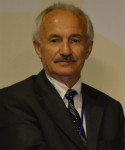| Biography | |
|---|---|
 Prof. Osman Adiguzel Firat University, Turkey |
|
| Title: Displacive Transformations and Multivariant Nature of Martensite in Shape Memory Alloys | |
| Abstract: Shape memory alloys are stimulus responsive materials due to the response to external condition take place in the class of smart or intelligent materials. These alloys recover previously defined shape on heating after deformation in low temperature product phase condition in bulk level, and return back to deformed shape on cooling. Successive thermal induced and stress induced martensitic transformation govern this behavior. Thermal induced transformation occurs with cooperative movement of atoms on close packed planes of parent phase lattices on cooling. Thermal induced martensite occurs as lattice twinning by means of lattice invariant shear, and the twinned martensite structures turn into detwinned structures by means of stress induced transformation. The detwinned structures turn into ordered parent phase structure by means of revere martensite-austenite transformation on heating. The cycling behavior can be called thermoelasticity and governed thermally by advanced austenite-martensite and reverse martensite-austenite transformations on cooling and heating after deformation. Shortly one can say that the microstructural mechanisms responsible for the shape memory effect are the twinning and detwinning processes as well as martensitic transformation. Therefore, the twinning and detwinning processes have great importance in the shape memory behaviour of the materials. Martensitic transformation occurs as martensite variants in self-accommodation manner with inhomogeneous lattice invariant shears in two opposite directions, <110 > -type directions on the {110}-type planes of austenite matrix which is basal plane of martensite. The {110}-plane family has 6 certain lattice planes; {110}, {1 -1 0}, {101}, {1 0 -1}, {011}, {0 1 -1}; and totally 24 martensite variants is obtained by means of the lattice invariant shears on <110 > -type direction on these planes. Copper based alloys exhibit this property in metastable β-phase region, which has bcc-based structures at high temperature parent phase field. Lattice invariant shear is not uniform in copper based shape memory alloys, and these types of shears gives rise to the formation of multilayered complex structures , like 3R, 9R or 18R depending on the stacking sequences on the close-packed planes of the ordered lattice. The unit cell and periodicity is completed through 18 layers in direction z, in case of 18R martensite, and unit cells are not periodic in short range in direction z. In the present contribution, x-ray diffraction and transmission electron microscopy studies were carried out on two copper based CuZnAl and CuAlMn alloys. X-ray diffraction profiles and electron diffraction patterns exhibit super lattice reflections inherited from parent phase due to the diffusion less character of martensitic transformation. X-ray diffractograms taken in a long time interval show that diffraction angles and intensities of diffraction peaks change with the aging time at room temperature. This result refers to a new transformation in diffusive manner. Keywords: Shape memory effect, martensitic transformation, martensite variant, lattice twinning and detwinning. | |
| Biography: Dr. Osman Adiguzel graduated from Department of Physics, Ankara University, Turkey in 1974 and received PhD- degree from Dicle University, Diyarbakir-Turkey. He studied at Surrey University, Guildford, UK, as a post doctoral research scientist in 1986-1987, and his studies focused on shape memory alloys. He worked as research assistant, 1975-80, at Dicle University and shifted to Firat University in 1980. He became professor in 1996, and he has been retired due to the age limit of 67; following academic life of 45 years. He published over 60 papers in international and national journals; He joined over 100 conferences and symposia in international and national level as participant, invited speaker or keynote speaker with contributions. He served the program chair or conference chair/co-chair in some of these activities. In particular, he joined in last six years (2014 - 2019) over 60 conferences as Speaker, Keynote Speaker and Conference Co-Chair organized by South Asian Institute of Science and Engineering (SAISE), web: http://saise.org/, Science and Engineering Institute (SCIEI), web: http://www.sciei.org, International Association of Computer Science and Information Technology, web: http://www.iacsit.org/, Scientific Federation, web: https://scientificfederation.com/, IASED, web: http://www.iased.org/ , The Academic World Education and Research Center (AWER-Center), web: http://www.awer-center.org/, and other institutes and companies. Dr. Adiguzel served his directorate of Graduate School of Natural and Applied Sciences, Firat University in 1999-2004. He supervised 5 PhD- theses and 3 M.Sc theses. He is also Technical committee member of many conferences. He received a certificate which is being awarded to him and his experimental group in recognition of significant contribution of 2 patterns to the Powder Diffraction File – Release 2000. The ICDD (International Centre for Diffraction Data) also appreciates cooperation of his group and interest in Powder Diffraction File. Scientific fields of Dr. Adiguzel are as follow: Shape memory effect and displacive phase transformations in shape memory alloys and other alloys, molecular dynamics simulations, alloy modeling, electron microscopy, electron diffraction, x-ray diffraction and crystallography. | |
